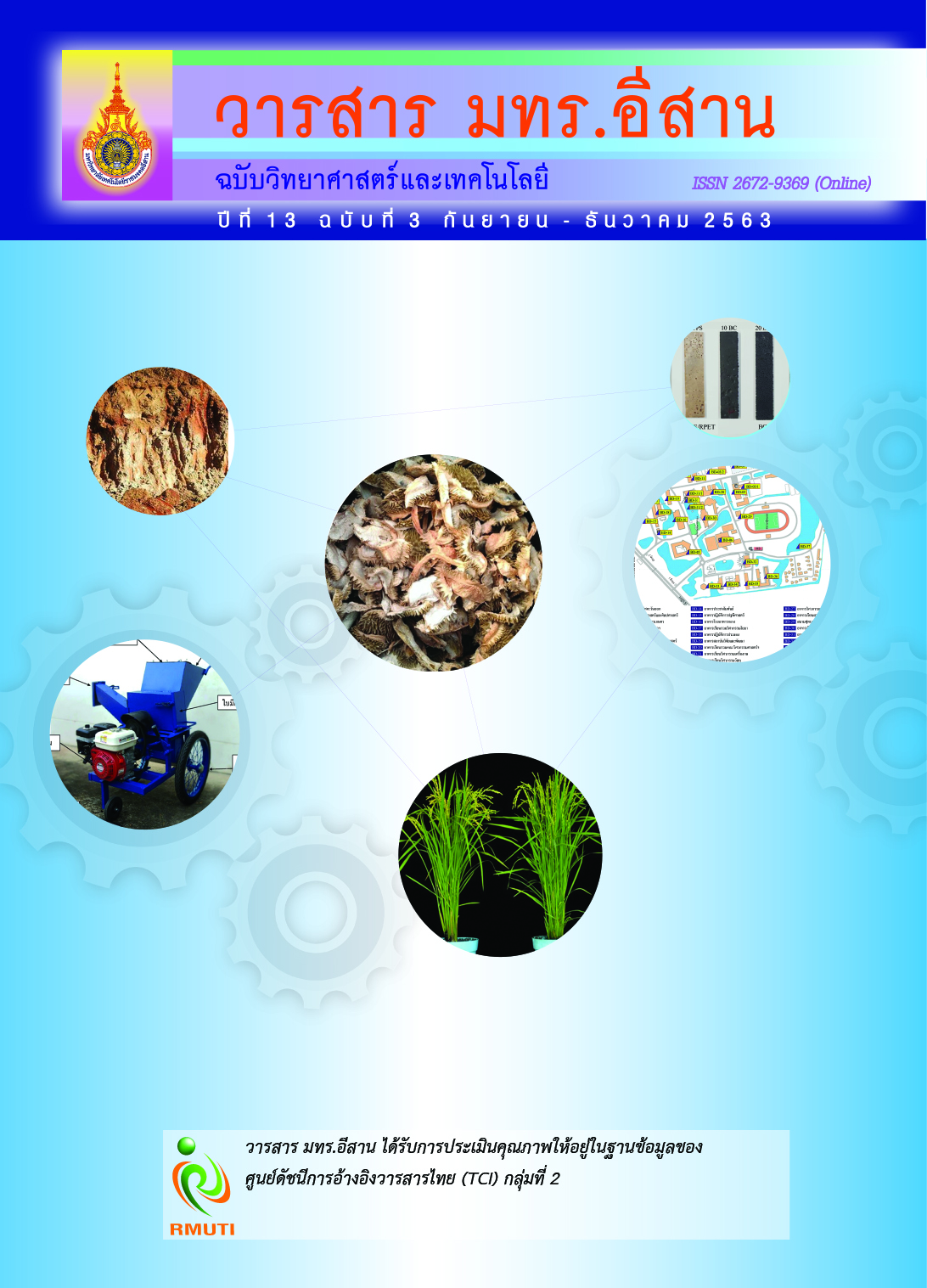Preparation of Biocomposite from Recycled PET Bottle and Starch Reinforced with Biochar from Durian Peels
Main Article Content
Abstract
This research focuses on the preparation of biodegradable films from recycled polyethylene terephthalate (RPET) and thermoplastic starch (TPS) reinforced with biochar from durian peels. In this study, hexamethylene diisocyanate (HMDI) was used as a compatibilizer and the influences of biochar contents on physical properties, morphology, mechanical properties, thermal properties and water absorption ability of biocomposite films were studied. For biocomposite preparation, all ingredients, i.e. TPS, RPET biochar and HMDI were mixed by internal mixer and fabricated into thin sheet by compression molding. The mixing ratio of TPS/RPET was fixed at 30/70 wt%, while HMDI was added at 5wt% based on starch content. Biochar contents were varied from 10 to 40 wt%. The results showed that the presence of 5wt% HMDI led to improvement of mechanical and thermal properties of TPS/RPET compound which resulted from the improvement of interfacial adhesion between RPET and TPS. Moreover, the addition of 20 wt% biochar resulted in the highest flexural strength and flexural modulus of 30TPS/RPET when compare to other biochar contents because of its better dispersion in RPET matrix. In addition, biochar could improve thermal stability of 30TPS/RPET biocomposite. Besides, the water absorption ability of TPS/RPET/biochar composite was increased when TPS and biochar increased. On the other hand, the presence of HMDI led to the diminish of water absorption ability of TPS/RPET/biochar biocomposite.
Article Details
References
Bhandhubanyong, P. and Sirirangsi, P. (2019). New Trends and Challenges for Agriculture in the Mekong Region: From Food Security to Development of Agri-Businesses. The Development of Agricultural Tools in Thailand:Case Studies of Rice and Maize. (Sakata, S.). BRC Research Report, Bangkok Research Center, JETRO Bangkok/IDE-JETRO
Kan, R., Kungkajit, C., and kaosol, T. (2017). Recycle of Plastic Bag Wastes with Organic Wastes to Energy for RDF Productions. American Journal of Applied Sciences. Vol. 14, No. 2, pp. 1103-1110. DOI: 10.3844/ajassp.2017.1103.1110
Chiu, H. and Hsiao, Y. (2006). Compatibilization of Poly (ethylene terephthalate)/Polypropylene Blends with Maleic Anhydride Grafted Polyethylene-Octene Elastomer. Journal of Polymer Research. Vol. 13, Issue 2, pp. 153-160. DOI: 10.1007/s10965-005-9020-z
Chotthong, B. (2018). Public-Private-People Partnerships on Plastic Waste Management in Thailand. EAS Congress. 27-30 November 2018. Lloilo Convention Center, Philipines.
Wichai-utcha, N. and Chavalparit, O. (2019). 3Rs Policy and Plastic Waste Management in Thailand. Journal of Material Cycles and Waste Management. Vol. 21, Issue 1, pp. 10-22. DOI: 10.1007/s10163-018-0781-y
Park, S. H. and Kim, S. H. (2014). Poly (ethylene terephthalate) Recycling for High Value Added Textiles. Fashion and Textiles. Vol. 1, Issue 1, pp. 1-17. DOI: 10.1186/s40691-014-0001-x
Soroudi, A. and Jakubowicz, I. (2013). Recycling of Bioplastics, Their Blends and Biocomposites: A Review. European Polymer Journal. Vol. 49, Issue 10, pp. 2839-2858. DOI: 10.1016/j.eurpolymj.2013.07.025
You, X., Snowdon, M. R., Misra, M., and Mohanty, A. K. (2018). Biobased Poly(ethylene terephthalate)/Poly(lactic acid) Blends Tailored with Epoxide Compatibilizers. American Chemical Society. Vol. 3, pp. 11759-11769. DOI: 10.1021/acsomega.8b01353
Threepopnatkul, P., Wongnarat, C., Intolo, W., Suato, S., and Kulsetthanchalee, C. (2014). Effect of TiO2 and ZnO on Thin Film Properties of PET/PBS Blend for Food Packaging Applications. Energy Procedia. Vol. 56, pp. 102-111. DOI: 10.1016/j.egypro.2014.07.137
Kiziltas, A., Gardner, D. J., Han, Y., and Yang, H. (2010). Determining the Mechanical Properties of Microcrystalline Cellulose (Mcc)-filled PET-PTT Blend Composites. Wood and Fiber Science. Vol. 42, Issue 2, pp. 165-176.
Wiącek, A. E., Jurak, M. ł., Gozdecka, A., and Worzakowska, M. (2017). Interfacial Properties of PET and PET/Starch Polymers Developed by Air Plasma Processing. Colloids and Surfaces A: Physicochemical and Engineering Aspects. Vol. 532, pp. 323-331. DOI: 10.1016/j.colsurfa.2017.04.074
Nguyen, D. M., Do, T. V. V., Grillet, A., Thuc, H., and Thuc, C. N. H. (2016). Biodegradability of Polymer Film Based on Low Density Polyethylene and Cassava Starch. International Biodeterioration & Biodegradation. Vol. 115, pp. 257-265. DOI: 10.1016/j.ibiod.2016.09.004
Gattin, R., Copinet, A., Bertr, C., and Couturier, Y. (2001). Comparative Biodegradation Study of Starch- and Polylactic Acid-Based Materials. Journal of Polymers and the Environment. Vol. 9, pp. 11-17. DOI: 10.1023/A:1016036302871
Muller, J., González-Martínez, C., and Chiralt, A. (2017). Combination of Poly(lactic) Acid and Starch for Biodegradable Food Packaging. Materials. Vol. 10, Issue 8, p. 952. DOI: 10.3390/ma10080952
Gonzalez-Ausejo, J., Sanchez-Safont, E., Lagaron, J. M., Balart, R., Cabedo, L., and Gamez-Perez, J. (2016). Compatibilization of Poly(3-hydroxybutyrate-co-3-hydroxyvalerate)-Poly(lactic acid) Blends with Diisocyanates. Journal of Applied Polymer Science. Vol. 134, Issue 20, DOI: 10.1002/app.44806
Idrees, M., Jeelani, S., and Rangari, V. (2018). Three-Dimensional-Printed Sustainable Biochar- Recycled PET Composites. ACS Sustainable Chemistry & Engineering. Vol. 6, pp. 13940-13948. DOI: 10.1021/acssuschemeng.8b02283
Rehraha, D., Reddye, M. R., Novakd, J., Bansode, R., Schimmel, K., Yu, J., Watts, D.W. and Ahmedna, M. (2018). Production and Characterization of Biochars from Agricultural by-Products for use in Soil Quality Enhancement. Journal of Analytical and Applied Pyrolysis. Vol. 108, pp. 301-309. DOI: 10.1016/j.jaap.2014.03.008
Ferri, J. M., Garcia, D., Carbonell-Verdu, A., Gimeno, O. F., and Balart, R.. (2017). Poly(lactic acid) Formulations with Improved Toughness by Physical Blending with Thermoplastic Starch. Journal of Applied Polymer Science. Vol. 135, Issue 4, p. 45751. DOI: 10.1002/app.45751


